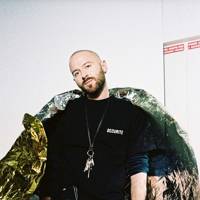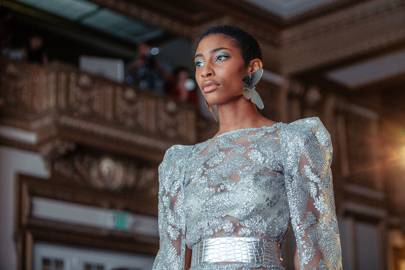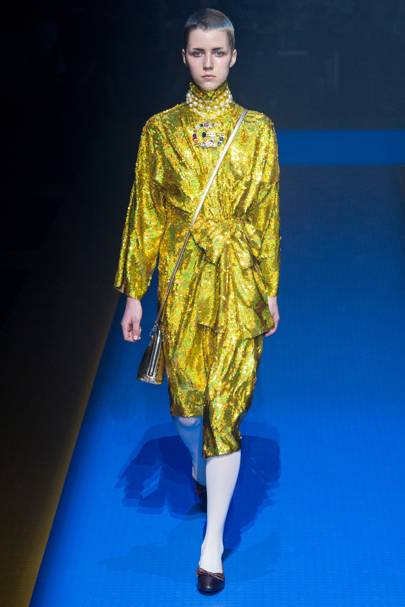The first in a series of casual interviews, Vetements and Balenciaga designer Demna Gvasalia opens up to Vogue’s fashion critic Anders Christian Madsen about his new lifestyle and the chaotic shoot to fashion fame that went before it.
A traditional Parisian restaurant in the 7eme wasn’t what I had expected when I asked Demna Gvasalia to take me to lunch in late August. He turns up looking ever the rock star, in a graphic geo-print prototype Balenciaga shell jacket and matching cap pulled down halfway over his eyes. “You brought me out of this no-press hibernation period,” he reminds me. In the past year the Vetements designer has evaded the in-depth conversations of the first part of his career in the spotlight, a skyrocket, which – mad as it sounds to anyone with a wardrobe full of his impossibly long-sleeved hoodies and artisanal jeans – only took off in 2014. In January this year, he amazed his industry by relocating Vetements to Zurich (of all places) with his brother Guram Gvasalia, the brand’s CEO. “My lifestyle changed completely in one year. I’m a different Demna now,” he declares, and orders a fresh lemon tea. The brand had become a banner leader for a new avant-garde youth in Paris and around the world, thanks to a social-media generation of millennial streetwear worshippers, whose hearts Gvasalia’s subversive designs pierced at the right time and place.

His adoptive home wasn’t the catalyst for the reformed Swiss lifestyle the 36-year-old designer now swears by, with all the runs by the lake, vegetarianism and no-alcohol-or-cigarettes policies it has entailed. It was the solution. “I felt suffocated by that new wave that we became part of with Vetements. It got to the point where I got fucking bored of it; being associated with nightclubs, Paris youth, the gang,” he admits. “It’s great, but I felt Vetements grew out of it, partly due to the commercial success but mainly because we grew in every way. I felt we needed to get out of it, but it’s a good thing it now exists, for others to evolve it further.” The out-of-nowhere rise of Vetements – and Gvasalia as the star-is-born designer – resonated with a new order in the fashion establishment, where houses suddenly dared to hire emerging or unknown designers (beginning with Alessandro Michele at Gucci, and followed by Anthony Vaccarello at Saint Laurent) and rogue cult brands rapidly took centre stage (Off-White, Gosha Rubchinskiy, Koché, to name a few).
"I felt suffocated by that new wave that we became part of with Vetements. It got to the point where I got fucking bored of it".
Gvasalia became creative director at Balenciaga in that process, and he’s meeting me between fittings – Le Petit Lutetia is down the road from those ateliers. A charming (and suspiciously fashionable) restaurant decked out in Belle Epoque mirrors, wooden screens and the occasional palm tree. “It’s not just because it’s close to Balenciaga,” he insists. “I actually come here on the weekends when I’m in Paris.” Now in a long-term relationship with Loïk Gomez, a metal musician who sometimes walks his men’s shows, Gvasalia is about to move out of his old bachelor pad on Rue Saint-Martin, which has a view to Jean Paul Gaultier’s office, and which he took out at the height of his Prince Bertie-worthy Parisian debauchery years. “I can’t any more. We have people getting run over in the street at seven in the morning. It’s so loud. Plus, I can’t listen to music loud because of neighbours,” Gvasalia says, eyes rolling. His new home away from Zurich? Bois de Boulogne, where he showed his last Balenciaga men’s collection, and “where there’s no outside noise and I can play music as loud as I want”.
So perhaps this trendy bistro wasn’t so misrepresentative of the new Demna Gvasalia after all. The food arrives: parma ham, melon and king crab for the writer; tomato salad and an enormous artichoke for Gvasalia, the awkward desirability of which could easily be a metaphor for the garments he makes. Trying to be ladylike fiddling with the leafy alien, he breaks into laughter. “I feel like Audrey Hepburn!” Is this his life now, then, elegantly nipping at artichoke leaves in bourgeois Parisian establishments? “No,” he says. “My life is happy now.” Was there a time he wasn’t? “Yeah. Remember the show I did in the church?” Gvasalia pauses, referring to his autumn/winter 2016 show with the famous slogan jumper, “May The Bridges I Burn Light My Way.” “That was the heaviest time I ever experienced. A lot of shit was going on in my private life and I didn’t really know what I wanted. In my professional life I was doing what I loved doing, but I had a relationship that didn’t work,” he reflects. “A lot of things changed for me when I started doing two jobs and having less time for friends; taking a healthier path changed my relationships with people.”
Being “the coolest man in Paris”, as I called him when I first met Gvasalia at the dawn of the super-fame that would hit him like an avalanche of groupies, would become a claustrophobic box to live in. Alongside his fellow fashion Soviets – the designer Gosha Rubchinskiy and the stylist Lotta Volkova – he inadvertently became the poster boy for a trend that was simply part of his roots, growing up in Georgia’s now-separatist Abkhazia region and fleeing civil war on a donkey over the Caucasus Mountains at age 14 – a harrowing childhood story too heartbreaking for this jovial lunch to do justice. “Sometimes I have to tell my boyfriend about this period of my life he doesn’t know about. Georgia, the mountains, selling Kalashnikovs... I always feel a bit ashamed, as if people think I’m bullshitting them.” His family eventually relocated to Düsseldorf where Gvasalia spent his late teens, although they briefly lived in Russia.
“This Russian thing, I can’t any more,” he announces, having conquered the artichoke. “They put me, Gosha and Lotta in this one big Russian rustic bucket of post-Soviet dirt,” he laughs. “We’re all friends, we work together. There’s not so many Russian people in fashion. I love Russia, Russia is my home country in many ways, but I don’t like many things about Russia today related to the political mentality.” Those post-Soviet waves were washing over fashion when he did that show in the church and wore the T-shirt backstage about burning bridges. “That was the way I felt at the time. It was about myself. I always tried to do things for other people, or for my parents to be proud of me, but I never thought about myself until the moment I realised it’s quite self-destructive,” he reflects. “But you shouldn’t burn all the bridges.” Slowly, as his fame and fortune grew and Justin Bieber was Instagramming deifying pictures of him, a new Demna Gvasalia began to emerge. “It motivated my decision to discover who I truly am, and to love and appreciate myself and my life, and the people around me – even if it’s only a few people,” he says.

As for those no longer a part of Gvasalia’s reality, “it happened naturally because you don’t have the lifestyle any more. It’s a kind of therapy: to understand what real friendship is, and what people you can actually rely on. I thought, I want less... but more quality.” It triggered his new way of life. “I went to do yoga, can you imagine?” he laughs. “Well, I went once...” Now appropriately illuminated by a complimentary plate of radishes, Gvasalia is full of reflections on mindfulness and wellbeing – worlds away from the chain-smoking encounters we had during the first stage of his career. “When you finally reach the point where you think, ‘There’s nothing else I can talk to Demna about’ – there’s meditation!” he quips. But Gvasalia is in no way annoying or holier-than-thou about his born-again sanity. Rather, it’s clarified the charming no-nonsense casualness that made us fall at his feet in the first place, as the breath of fresh air fashion so needed."It’s a kind of therapy: to understand what real friendship is, and what people you can actually rely on".
“Fashion is sex, drugs and rock’n’roll, but for me it’s also responsibility and my interest in clothing, which I don’t want to become a Fashion-Week experience. I needed the silence and to go and discover myself,” he explains. “I’m still doing it and I’m going to be doing it for the rest of my life.” Practically incognito in Zurich, which he’s affectionately described as “the most boring place in Europe”, he’s had space to geek out on fashion, true to his nature. In June, Gvasalia presented a Vetements collection shot there on locals in the cliché fashion poses he’s been obsessing about. Classic lookbook poses were the inspiration for his previous Balenciaga women’s collection, while he said his spring/summer 2018 outing in October (presented a month after this lunch) signified his most personal work for Balenciaga yet. Both brands continue to make waves on the social-media channels that fuel Gvasalia’s star power. Last season, his IKEA-esque Balenciaga bag spawned an entire capsule campaign from the Swedish homeware giant, while Gvasalia’s election-inspired Balenciaga motifs, not dissimilar to those of Bernie Sanders’s campaign, got a mention from the presidential candidate in a cable news interview. That notion does bring a smile to Gvasalia’s face, but he’s not one for the social-media circus.
“Oh no, those things I don’t react to. For me it’s a bit like the whole Vetememes thing,” he says, referring to the unofficial meme outlet devoted to his brand. Other phenomena include Petements, an Instagram account that imagines pets in Vetements. “The internet craziness... I don’t want to get involved. It becomes a bit slapstick. I don’t like slapstick,” he shrugs. “I’m working on a project that will be my answer to all of that, in January. I’m going to answer with a collection,” he teases. “You will see. Next season is the first season I’ll do it. It’s maybe something most people think you should never do. I feel like this excites me. We had a lot of options: what could it be? So I thought, let’s take the worst and let’s work with that. Something nobody would expect you to do. For me it’s linked to the past of Vetements; where we come from.” He doesn’t mean Georgia, although he happily answers fan mail from kids in his home country. “If someone did that to me when I was a kid, it would probably have had an influence.”"The internet craziness... I don’t want to get involved. It becomes a bit slapstick. I don’t like slapstick"
The fame, however – much as it clings to him – is not a guise Gvasalia wears with ease. “It’s disturbing. It’s flattering, but I can’t do it, because maybe I’m not that comfortable with myself, still. I don’t think it will ever be part of my character.” Rather than basking in the spotlight offered to him on a plate by his social-media-savvy millennial super-fans, Gvasalia has become their friend and defender, in a time when the media paints out the so-called snowflake generation as complacent and fame-hungry. “My millennial friends are not that way,” he argues, now on to a decaf coffee. “The people I know, who are 10 years younger than me, they’re all very ambitious and work hard. They’re also very good people. The values they have in life are good: they don’t want war, they don’t judge, they’re for diversity. There are so many good things about this generation. They just want it different. They want to have fun. They want to have money to have a good life,” Gvasalia says, and pauses. “Why not? That’s not a bad thing.”













































